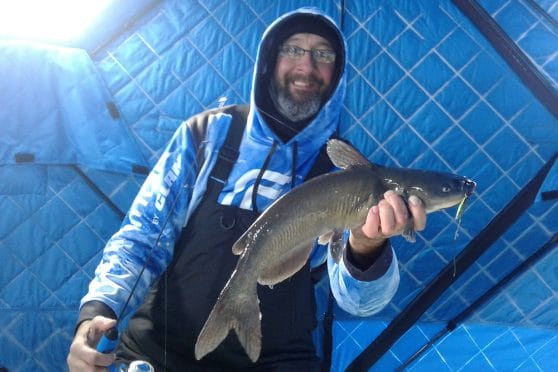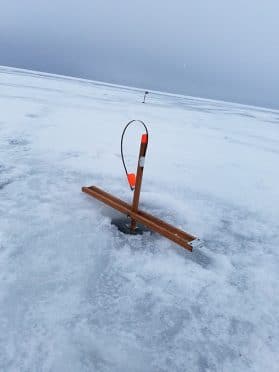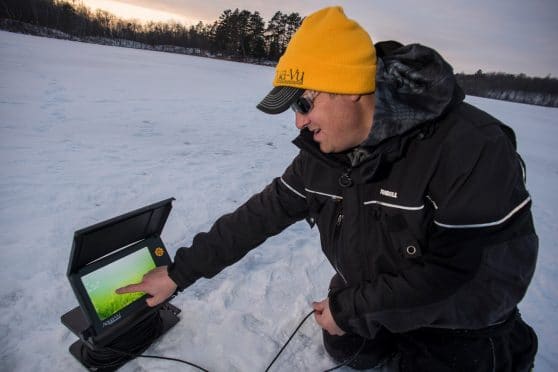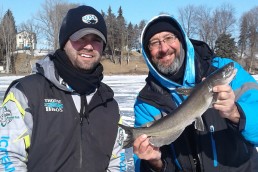Catfish Opportunities Through the Ice
SHARE THIS POST
When the talk turns to fishing through the ice, you often hear stories of walleye, trout, pike, panfish and most of the other popular game species. Rarely, is the word catfish used in the same sentence as ice-fishing.
That is too bad. Catching cats through the ice as they use their power to strip line from your reel is about as exciting as it gets on the ice. If you have ever caught catfish during the summer and experienced their strength, multiply that by 10 to get an idea of catching one through the ice on tiny ice-fishing tackle.
Catfish are a warmwater species, meaning they don’t go dormant during the winter. Early and late ice will find them at their most aggressive feeding stage during the winter. In between, they are not as aggressive. But, they are still catchable.
Electronics are a valuable tool when ice-fishing for any species. They’re especially helpful when chasing catfish all over big bodies of water. Catfish seem to congregate in large pods as the water temperature drops in the fall. This normally begins to happen when the water hits about the 45-degree mark.
A feast or famine situation
Because the fish are in large pods, a lot of the water will be free of catfish. It will take a lot of searching to find them. But, when you do find them, you will find a lot of them. Then, the fishing will be fast-paced!

The trick is to be mobile. Stay on top of them as they move about their feeding grounds. Catfish can travel a good distance—often several hundred yards—on big bodies of water as they eat. This will require the angler to do a lot of drilling as you move with the fish.
An underwater camera can be a big advantage. It will help you identify where the fish are in regards to the bottom. Some fish might be directly on the bottom. Other fish in the same pod could range from being on the bottom to 10-feet off the bottom. I’ve been using underwater cameras from Aqua-Vu the last few years and have had great success with them.
Also, a camera can help you identify which way the fish are traveling and how they are reacting to bait presentation.
Small bodies of water, like ponds and small lakes, make it easier to find fish. Begin in the deepest hole. They will be at or very near the bottom.
In bigger lakes, catfish will be in the 15- to 30-foot range. They can sometimes be deeper, but not often. They prefer a soft bottom with rolling structure and little weeds.
‘X’ marks the spot for big fishing groups

When you have a group of anglers that can keep an eye on multiple setups, make an “x” pattern of tip-ups. On the outside edge of the tip ups, place Automatic Fishermans. In the center, drill holes that you can jig from. Place your tip-ups and Automatic Fishermans in varying depths. This will help you locate the fish quicker.
Are you enjoying this post?
You can be among the first to get the latest info on where to go, what to use and how to use it!
With the Automatic Fisherman, the hook is set automatically. With the tip-ups, the angler has to set the hook. Because catfish don’t hold on to the bait long before spitting it out, you have to get to them within a few seconds to set the hook.
You can either begin jigging right away, or you can wait for one of the other rigs to go off. When an outer Automatic Fisherman goes off, that likely means the fish are feeding. You will have several fish in a short amount of time. If you have enough guys to take care of the other setups, one or two anglers needs to start jigging at the first sign of fish in the area.
Channel catfish will not eat large bait during the winter months. Live minnows, fresh cut bait no more than 1 1/2-inches in size, nightcrawlers and chicken livers are all good choices for bait.
Keep experimenting until you find what tickles the fish
Set your lines with a variety of baits until you see what the fish want. Put on fresh bait every 20 minutes or so. This will ensure a good scent trail is carried through the water. Starting out, suspend your bait about two feet off the bottom.
Also, as you change baits, change the depth of the bait if you have not been catching fish. It might take a few adjustments to find where the fish are. Again, an underwater camera can speed up the process.
Jigging for catfish is really no different than jigging for other species of fish. You just will need a rod and reel that withstand the power of a big catfish. Also, I recommend 12-pound, no-stretch line with a small swivel attached, then a 30-inch leader consisting of 12-pound-test fluorocarbon followed up with a snap.
Good electronics and good bait will bring home big fish
Electronics are very important when fishing for catfish. Use them to mark fish, concentrating on the bottom three feet of water. Once a fish shows up on your screen, do several jigging techniques until the fish can’t take it any longer and bites.

Spoons topped with waxworms, redworms, nightcrawlers and minnow heads work well. Also, swimming lures like a jigging Rapala work well.
For deeper water, more than 15 feet, 1/4- to 3/8-ounce jigheads topped with cutbait work well. Bladebaits can also be used to coax a fish into biting.
Your jigging technique should begin with a “pop” every now and then. When a fish shows on the electronics, stop jigging and let the fish find your bait. If that doesn’t work, move the bait about a foot above the fish and wait. This subtle move is often enough to entice a fish to bite. You must be slow with your movements. Anything done too quickly is liable to scare the fish. A motionless bait or one that is just barely moved will often a cause a fish to strike.
Ice-fishing for catfish isn’t new. It is just overlooked by many anglers that would prefer to catch the gamefish species. But, if you like a hard-fighting fish that tastes good in the frying pan, go after catfish this winter.
Did you enjoy this post?
You can be among the first to get the latest info on where to go, what to use and how to use it!
Jason Houser
Jason Houser is an avid outdoorsman from Central Illinois. Houser has been a full-time freelance writer since 2008. He is also the host of Jason Houser Outdoors, airing on the Hunt Channel. He can be found on Facebook at Jason Houser Outdoors or on the web at jasonhouseroutdoors.com.


